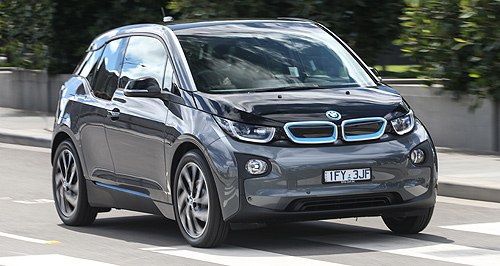Make / Model Search
News - General News - Electric VehiclesCo-operation needed for EV adoption: governmentModel citizen: Tesla’s Model S has been on sale in Australia since 2014, but sales of the all-electric sedan likely pale in comparison to its internal-combustion rivals including the BMW 5 Series and Mercedes-Benz E-Class. Preparation required as Australian EVs set to explode to one million over 12 years15 Jan 2018 By TUNG NGUYEN FEDERAL minister for environment and energy Josh Frydenberg has cautioned that Australia could be left behind if caught unprepared by the imminent electric vehicle (EV) revolution and has called for increased co-operation of governments at the national and state level. Publishing a comment piece on The Sydney Morning Herald last Friday, Mr Frydenberg said more could be done to increase the uptake of EVs Down Under, but did not specifically state if Australia needs an emissions-free incentive program similar to some other markets around the world. “There is a lot of activity already occurring at federal, state and industry level, but there is a need for greater coordination,” he said. “Better coordination of existing and future activities around research and development, charging infrastructure planning, vehicle fleet targets and financial incentives, will bode well for the industry in the exciting decade ahead. “A global revolution in electric vehicles is under way and with the right preparation, planning and policies, Australian consumers are set to be the big beneficiaries.” Although some markets including Norway, the Netherlands and California have introduced incentives in the form of tax breaks for drivers of emissions-free vehicles, Volkswagen Australia managing director Michael Bartsch told journalists last November that he believes government enticements are “fundamentally wrong”. On the other hand, brands including Jaguar, Land Rover and Mercedes-Benz believe government intervention – which has so far remained non-existent – is vital for EVs to gain mass market traction. Mr Frydenberg highlighted Australia’s low emissions-free vehicle adoption rates as an area that will improve in future once new technologies and more charging infrastructure comes on stream. “In Australia, the emergence of electric vehicles is a different story,” he said. “Currently, there are 4000 such vehicles on the road, making up just 0.1 per cent of new vehicle sales. Indeed, New Zealand, which is one-fifth of the population of Australia, has already similar number of electric vehicles on its roads. “The lack of take-up is not because of a lack of consumer interest. Australian surveys show that about half the people in the market for a new car are prepared to consider purchasing an electric vehicle with many investigating it. “But what holds them back are issues relating to price, range and infrastructure.” Mr Frydenberg said however, EV prices will fall once second-hand cars hit the market after fleets hit their three-to-five year expiration, as well as new vehicles – including the much-hyped entry-level Tesla Model 3 – landing in showrooms. EV technology is also constantly improving, with new battery technology on the horizon expected to increase the current all-electric driving range of about 350km to over 1000km. “The infrastructure of electric vehicles is also rapidly becoming more feasible for long distance journeys,” Mr Frydenberg said. “While Australia’s 476 public charging stations are just a fraction of the more than 60,000 you can find across Europe, it will quickly grow over time.” Mr Frydenberg predicts that over the next seven years, EVs will jump 575 per cent and will hit one million by 2030, which “will not only produce a good economic dividend for consumers, but also a better environmental outcome”. However, Mr Frydenberg warned that preparation of the electricity grid needs to take place to facilitate the ramp up of EV adoption. “One of the challenges that will come from the big increase in electric vehicles in Australia will be the demands on the electricity grid,” he said. “An extra one million electrics cars is the equivalent of 5.2 terawatt hours of power demand. This is about a two per cent increase in overall grid demand. “With 90 per cent of electric vehicles likely to be charged at home, the technology needs to be such that electric vehicle owners have the systems in place to charge their battery in the middle of the night when prices are low and not at the 5pm to 6pm time slow after work when prices are typically higher, reflecting increased household demand.” Electric Vehicle Council (EVC) CEO Behyad Jafari hailed Mr Frydenberg’s statement that calls for increased industry co-operation for EV adoption. “Australia’s national road fleet is among the least efficient in the developed world,” he said. “At a time when the electricity sector is increasingly powered by renewables, it makes sense to move our vehicles away from fossil fuels and power them from that clean source or energy. “The industry has been leading this transition, with investment in new models and charging infrastructure. What we need however is a signal that governments support the change to provide certainty for greater investment. “The answer, as identified by the minister is co-ordinated national plan to encourage and support the purchase of electric vehicles. That includes through short-term incentives, the co-ordinated deployment of charging infrastructure, integration of the electricity system and strong fleet targets.”  Read more13th of November 2017  Government necessary for EV uptake: BenzEV adoption ‘can’t happen without’ government according to Mercedes-Benz3rd of November 2017  No incentives needed for EVs: VolkswagenDeveloping EV market should be free of government interference, says VW boss22nd of August 2017  Exclusive: Premium brands plan EV charge networkCommercialised fast-charging EV network could be coming soon to Australia |
Click to shareGeneral News articlesResearch General News Motor industry news |










Facebook Twitter Instagram